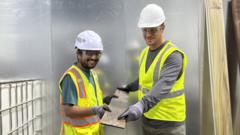Is This the New Bulletproof Wood You’ve Been Waiting For?

Could Your House Take a Bullet for You?
In an age where innovation meets sustainability, a groundbreaking development in the realm of construction materials has emerged. InventWood, a U.S.-based company, has introduced a modified wood known as Superwood, which claims to possess strength surpassing that of steel. This new material could revolutionize not only residential buildings but also military applications, potentially providing structures that can withstand extreme conditions.
Alex Lau, co-founder and executive chairman of InventWood, has shared intriguing insights into the capabilities of Superwood. During laboratory tests, a gas gun was employed to fire a bullet-like projectile at thin pieces of various wood types. While conventional wood crumbled under the impact, Superwood stood resilient, showcasing its robust nature. However, its potential military applications are still under consideration, as Lau humorously noted that "they haven't tried dropping bombs on it." This intriguing proposition raises questions about the durability and versatility of modern wood alternatives in construction.
The Search for Sustainable Alternatives in Construction
The construction industry is facing increasing scrutiny regarding its environmental impact, particularly with materials like concrete, which are associated with high greenhouse gas emissions. As the world strives to decarbonize construction, wood-based alternatives are gaining traction for their potential to combat climate change. Wood can store significant amounts of carbon over the long term, making it an attractive option for eco-friendly building practices.
However, traditional timber is not always suited for certain applications due to its susceptibility to moisture and pests. This is where engineered wood products shine. They are designed to be significantly stronger and more resilient, making them reliable materials for constructing everything from residential homes to towering skyscrapers. As the construction industry continues to explore the limits of wood, innovations like Superwood are paving the way for more sustainable building practices.
Understanding the Process Behind Superwood
So, what exactly makes Superwood so strong? The process of creating this modified wood involves treating timber with specific chemicals to remove lignin, a natural polymer found in wood. By compressing the wood extremely firmly, the volume is reduced by nearly 80%. This innovative approach allows for the creation of additional hydrogen bonds within the material, resulting in a product that is considerably stronger than its natural counterpart, even while being thinner.
A key advantage of Superwood is its ability to retain the natural wood grain, providing an aesthetically pleasing finish. Lau explains that the refinement of the production process has drastically improved over the years; what once took more than a week can now be accomplished in just a few hours. Initially, InventWood will utilize wood from poplar trees, but there’s also potential for bamboo, which can be grown in just three to four years, making it an efficient way to sequester carbon from the atmosphere.
Comparing Superwood to Other Engineered Wood Products
The market is already populated with various engineered wood products, each offering unique benefits. For example:
- Glulam: Glue-laminated timber, where layers of wood are glued together with the grain facing in the same direction, creating strong, moisture-resistant beams.
- Cross-laminated timber (CLT): Involves stacking layers of wood in alternating grain directions to form panels suitable for walls and floors, resembling a highly durable plywood.
Using CLT for construction can significantly reduce carbon emissions. A study published in June suggested that opting for CLT instead of concrete in building community centers could lower emissions associated with construction and building operations by nearly 10%. While Superwood is not intended to compete directly with these products, Lau envisions it providing a visually appealing and structurally sound finishing layer or serving as durable external cladding.
Expert Opinions on Superwood and Its Applications
The potential of Superwood has garnered attention in the academic community as well. Morwenna Spear, a research fellow at Bangor University's BioComposites Centre, describes the technology as "promising." However, she raises important concerns regarding the durability of wood in varying environments, particularly in the UK, where weather conditions can fluctuate dramatically. Spear emphasizes the need for comprehensive data on Superwood's performance in such unpredictable climates.
Other companies are also making strides in engineered wood products. For instance, the German firm Pollmeier has developed BauBuche, a laminated veneer lumber made from beech wood, which is not typically favored for construction. By processing it into veneers, Pollmeier has uncovered a way to enhance the structural integrity of beech, making it a viable option for building materials.
Australia's 3RT company employs thin veneer sheets from low-value trees, or "pulp logs," to mimic the structure and density of more expensive hardwoods. This innovative approach has led to the use of their product in large window frames, kitchen cabinets, and furniture. With the emergence of these new wood products, architects and designers now have a broader palette from which to choose, creating exciting possibilities for the future of building design.
Challenges and Considerations in Wood Construction
Despite advancements in engineered wood products, challenges remain in their widespread adoption. Professor Michael Ramage, director of the Centre for Natural Material Innovation at the University of Cambridge, highlights financial barriers such as mortgage and insurance rates for wood constructions compared to traditional concrete buildings. He advocates for the increased use of wood primarily due to its carbon-storing capabilities, even acknowledging that certain construction applications will always require concrete for foundational support.
Addressing Safety Concerns: Fire Resistance and Pests
In light of recent wildfires, concerns about the safety of using wood in construction have surfaced. Lau asserts that Superwood has undergone fire resistance testing and has performed admirably, dispelling fears that wood is inherently unsafe. Furthermore, it has also proven resistant to wood-eating insects, adding another layer of durability that makes it an attractive choice for builders.
The Importance of Recycling in the Wood Industry
As innovative as engineered wood products are, it is crucial not to overlook the importance of recycling existing timber. Dr. Spear points out that researchers in the UK have successfully repurposed waste wood from demolished buildings into CLT-style panels, demonstrating the potential for reusing materials effectively. In fact, many households already utilize a variety of recycled wood products in their furniture, such as particle board, which is largely derived from recycled timber.
The Future of Wood in Construction
With an increasing array of engineered wood products available, the possibilities for sustainable construction are expanding. Superwood represents a significant advancement in wood technology, offering strength, beauty, and environmental benefits. Yet, as the industry evolves, ongoing research, testing, and public acceptance will play pivotal roles in shaping the future of wood as a building material.
FAQs
What is Superwood and how is it made?
Superwood is a modified wood product that boasts strength greater than steel. It is produced by treating timber with chemicals to remove lignin and compressing it to create additional hydrogen bonds, resulting in a durable material that retains its natural wood grain.
What are the environmental benefits of using wood in construction?
Wood is a renewable resource that can store carbon over long periods. Using wood-based materials in construction can significantly reduce greenhouse gas emissions associated with building operations, making it a more sustainable choice compared to traditional materials like concrete.
Is Superwood fire-resistant?
Yes, Superwood has undergone fire resistance testing and has demonstrated its ability to withstand fire, addressing concerns about using wood in construction, especially in fire-prone areas.
Can Superwood be used for external cladding?
Absolutely! Superwood has the potential to serve as a durable external cladding material, providing both aesthetic appeal and structural integrity for buildings.
What challenges does wood face in the construction industry?
Challenges include financial barriers, such as mortgage and insurance rates for wood constructions, as well as concerns about durability, fire resistance, and susceptibility to pests. These issues need to be addressed for wider adoption of wood products in construction.
As we consider the future of construction, the question remains: will innovations like Superwood change the landscape of building materials for good? With the push for sustainability and durability, we may be witnessing the dawn of a new era in architectural design. #SustainableBuilding #InnovativeMaterials #Superwood
Published: 2025-07-31 23:10:20 | Category: technology



